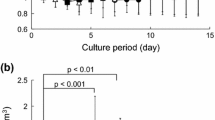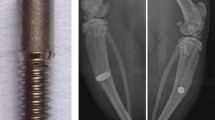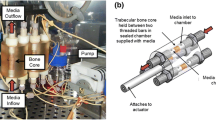Abstract
High-frequency, low-magnitude accelerations can be anabolic and anticatabolic to bone. We tested the hypothesis that application of these mechanical signals can accelerate bone regeneration in scaffolded and nonscaffolded calvarial defects. The cranium of experimental rats (n = 8) in which the 5-mm bilateral defects either contained a collagen scaffold or were left empty received oscillatory accelerations (45 Hz, 0.4 g) for 20 minutes per day for 3 weeks. Compared with scaffolded defects in the untreated control group (n = 6), defects with a scaffold and subject to oscillatory accelerations had a 265% greater fractional bone defect area 4 weeks after the surgery. After 8 weeks of healing (1-week recovery, 3 weeks of stimulation, 4 weeks without stimulation), the area (181%), volume (137%), and thickness (53%) of the regenerating tissue in the scaffolded defect were greater in experimental than in control animals. In unscaffolded defects, mechanical stimulation induced an 84% greater bone volume and a 33% greater thickness in the defect. These data provide preliminary evidence that extremely low-level, high-frequency accelerations can enhance osseous regenerative processes, particularly in the presence of a supporting scaffold.






Similar content being viewed by others
References
Aaron RK, Ciombor DM, Jolly G. Stimulation of experimental ossification by low-energy pulsing electromagnetic fields. J Bone Miner Res. 1989;4:227–233.
Abercromby AF, Amonette WE, Layne CS, McFarlin BK, Hinman MR, Paloski WH. Vibration exposure and biodynamic responses during whole-body vibration training. Med Sci Sports Exerc. 2007;39:1794–1800.
Ahn SH, Kim CS, Suk HJ, Lee YJ, Choi SH, Chai JK, Kim CK, Han SB, Cho KS. Effect of recombinant human bone morphogenetic protein-4 with carriers in rat calvarial defects. J Periodontol. 2003;74:787–797.
Cancedda R, Giannoni P, Mastrogiacomo M. A tissue engineering approach to bone repair in large animal models and in clinical practice. Biomaterials. 2007;28:4240–4250.
Chou LB, Mann RA, Coughlin MJ, McPeake WT III, Mizel MS. Stress fracture as a complication of autogenous bone graft harvest from the distal tibia. Foot Ankle Int. 2007;28:199–201.
Christiansen BA, Silva MJ. The effect of varying magnitudes of whole-body vibration on several skeletal sites in mice. Ann Biomed Eng. 2006;34:1149–1156.
Ciombor DM, Aaron RK. The role of electrical stimulation in bone repair. Foot Ankle Clin. 2005;10:579–593, vii.
Daly RM. The effect of exercise on bone mass and structural geometry during growth. Med Sport Sci. 2007;51:33–49.
David V, Martin A, Lafage-Proust MH, Malaval L, Peyroche S, Jones DB, Vico L, Guignandon A. Mechanical loading down-regulates peroxisome proliferator-activated receptor gamma in bone marrow stromal cells and favors osteoblastogenesis at the expense of adipogenesis. Endocrinology. 2007;148:2553–2562.
El-Mowafi H, Mohsen M. The effect of low-intensity pulsed ultrasound on callus maturation in tibial distraction osteogenesis. Int Orthop. 2005;29:121–124.
Foley KT, Mroz TE, Arnold PM, Chandler HC Jr, Dixon RA, Girasole GJ, Renkens KL Jr, Riew KD, Sasso RC, Smith RC, Tung H, Wecht DA, Whiting DM. Randomized, prospective, and controlled clinical trial of pulsed electromagnetic field stimulation for cervical fusion. Spine J. 2008;8:436–442.
Fritton SP, McLeod KJ, Rubin CT. Quantifying the strain history of bone: spatial uniformity and self-similarity of low-magnitude strains. J Biomech. 2000;33:317–325.
Gardner MJ, van der Meulen MC, Demetrakopoulos D, Wright TM, Myers ER, Bostrom MP. In vivo cyclic axial compression affects bone healing in the mouse tibia. J Orthop Res. 2006;24:1679–1686.
Garman R, Gaudette G, Donahue LR, Rubin C, Judex S. Low-level accelerations applied in the absence of weight bearing can enhance trabecular bone formation. J Orthop Res. 2007;25:732–740.
Garman R, Rubin C, Judex S. Small oscillatory accelerations, independent of matrix deformations, increase osteoblast activity and enhance bone morphology. PLoS ONE. 2007;2:e653.
Giannoudis PV, Dinopoulos H, Tsiridis E. Bone substitutes: an update. Injury. 2005;36(suppl 3):S20–S27.
Gilsanz V, Wren TA, Sanchez M, Dorey F, Judex S, Rubin C. Low-level, high-frequency mechanical signals enhance musculoskeletal development of young women with low BMD. J Bone Miner Res. 2006;21:1464–1474.
Ito K, Yamada Y, Naiki T, Ueda M. Simultaneous implant placement and bone regeneration around dental implants using tissue-engineered bone with fibrin glue, mesenchymal stem cells and platelet-rich plasma. Clin Oral Implants Res. 2006;17:579–586.
Jagodzinski M, Krettek C. Effect of mechanical stability on fracture healing: an update. Injury. 2007;38(suppl 1):S3–S10.
Judex S, Boyd S, Qin YX, Turner S, Ye K, Muller R, Rubin C. Adaptations of trabecular bone to low magnitude vibrations result in more uniform stress and strain under load. Ann Biomed Eng. 2003;31:12–20.
Judex S, Donahue LR, Rubin C. Genetic predisposition to low bone mass is paralleled by an enhanced sensitivity to signals anabolic to the skeleton. FASEB J. 2002;16:1280–1282.
Judex S, Lei X, Han D, Rubin C. Low-magnitude mechanical signals that stimulate bone formation in the ovariectomized rat are dependent on the applied frequency but not on the strain magnitude. J Biomech. 2007;40:1333–1339.
Jung UW, Song KY, Kim CS, Lee YK, Cho KS, Kim CK, Choi SH. Effects of a chitosan membrane coated with polylactic and polyglycolic acid on bone regeneration in a rat calvarial defect. Biomed Mater. 2007;2:S101–S105.
Kawate K, Yajima H, Ohgushi H, Kotobuki N, Sugimoto K, Ohmura T, Kobata Y, Shigematsu K, Kawamura K, Tamai K, Takakura Y. Tissue-engineered approach for the treatment of steroid-induced osteonecrosis of the femoral head: transplantation of autologous mesenchymal stem cells cultured with beta-tricalcium phosphate ceramics and free vascularized fibula. Artif Organs. 2006;30:960–962.
Leucht P, Kim JB, Wazen R, Currey JA, Nanci A, Brunski JB, Helms JA. Effect of mechanical stimuli on skeletal regeneration around implants. Bone. 2007;40:919–930.
Lim SC, Lee MJ, Yeo HH. Effects of various implant materials on regeneration of calvarial defects in rats. Pathol Int. 2000;50:594–602.
Mhawi AA, Peel SA, Fok TC, Clokie CM. Bone regeneration in athymic calvarial defects with Accell DBM100. J Craniofac Surg. 2007;18:497–503.
Miloro M, Miller JJ, Stoner JA. Low-level laser effect on mandibular distraction osteogenesis. J Oral Maxillofac Surg. 2007;65:168–176.
Mokbel N, Bou SC, Matni G, Naaman N. Healing patterns of critical size bony defects in rat following bone graft. Oral Maxillofac Surg. 2008;12:73–78.
Oishi M, Onesti ST. Electrical bone graft stimulation for spinal fusion: a review. Neurosurgery. 2000;47:1041–1055.
Ozcivici E, Garman R, Judex S. High-frequency oscillatory motions enhance the simulated mechanical properties of non-weight bearing trabecular bone. J Biomech. 2007;40:3404–3411.
Petrie Aronin CE, Sadik KW, Lay AL, Rion DB, Tholpady SS, Ogle RC, Botchwey EA. Comparative effects of scaffold pore size, pore volume, and total void volume on cranial bone healing patterns using microsphere-based scaffolds. J Biomed Mater Res A. 2008 Apr 28 [Epub ahead of print].
Pieper JS, Hafmans T, Veerkamp JH, van Kuppevelt TH. Development of tailor-made collagen-glycosaminoglycan matrices: EDC/NHS crosslinking, and ultrastructural aspects. Biomaterials. 2000;21:581–593.
Rubin C, Pope M, Fritton JC, Magnusson M, Hansson T, McLeod K. Transmissibility of 15-hertz to 35-hertz vibrations to the human hip and lumbar spine: determining the physiologic feasibility of delivering low-level anabolic mechanical stimuli to skeletal regions at greatest risk of fracture because of osteoporosis. Spine. 2003;28:2621–2627.
Rubin C, Recker R, Cullen D, Ryaby J, McCabe J, McLeod K. Prevention of postmenopausal bone loss by a low-magnitude, high-frequency mechanical stimuli: a clinical trial assessing compliance, efficacy, and safety. J Bone Miner Res. 2004;19:343–351.
Rubin C, Turner AS, Bain S, Mallinckrodt C, McLeod K. Anabolism: low mechanical signals strengthen long bones. Nature. 2001;412:603–604.
Rubin C, Turner AS, Mallinckrodt C, Jerome C, McLeod K, Bain S. Mechanical strain, induced noninvasively in the high-frequency domain, is anabolic to cancellous bone, but not cortical bone. Bone. 2002;30:445–452.
Rubin CT, Capilla E, Luu YK, Busa B, Crawford H, Nolan DJ, Mittal V, Rosen CJ, Pessin JE, Judex S. Adipogenesis is inhibited by brief, daily exposure to high-frequency, extremely low-magnitude mechanical signals. Proc Natl Acad Sci USA. 2007;104:17879–17884.
Seo YK, Song KY, Kim YJ, Park JK. Wound healing effect of acellular artificial dermis containing extracellular matrix secreted by human skin fibroblasts. Artif Organs. 2007;31:509–520.
Shen FH, Samartzis D, An HS. Cell technologies for spinal fusion. Spine J. 2005;5:231S–239S.
Silber JS, Anderson DG, Daffner SD, Brislin BT, Leland JM, Hilibrand AS, Vaccaro AR, Albert TJ. Donor site morbidity after anterior iliac crest bone harvest for single-level anterior cervical discectomy and fusion. Spine. 2003;28:134–139.
Skerry TM, Bitensky L, Chayen J, Lanyon LE. Loading-related reorientation of bone proteoglycan in vivo: strain memory in bone tissue? J Orthop Res. 1988;6:547–551.
Taylor KF, Rafiee B, Tis JE, Inoue N. Low-intensity pulsed ultrasound does not enhance distraction callus in a rabbit model. Clin Orthop Relat Res. 2007;459:237–245.
Vaccaro AR, Chiba K, Heller JG, Patel TC, Thalgott JS, Truumees E, Fischgrund JS, Craig MR, Berta SC, Wang JC. Bone grafting alternatives in spinal surgery. Spine J. 2002;2:206–215.
Verna C, Dalstra M, Wikesjo UM, Trombelli L. Healing patterns in calvarial bone defects following guided bone regeneration in rats: a micro-CT scan analysis. J Clin Periodontol. 2002;29:865–870.
Ward K, Alsop C, Caulton J, Rubin C, Adams J, Mughal Z. Low magnitude mechanical loading is osteogenic in children with disabling conditions. J Bone Miner Res. 2004;19:360–369.
Wolf S, Augat P, Eckert-Hubner K, Laule A, Krischak GD, Claes LE. Effects of high-frequency, low-magnitude mechanical stimulus on bone healing. Clin Orthop Relat Res. 2001;385:192–198.
Xie L, Jacobson JM, Choi ES, Busa B, Donahue LR, Miller LM, Rubin CT, Judex S. Low-level mechanical vibrations can influence bone resorption and bone formation in the growing skeleton. Bone. 2006;39:1059–1066.
Xie L, Rubin C, Judex S. Enhancement of the adolescent murine musculoskeletal system using low-level mechanical vibrations. J Appl Physiol. 2008;104:1056–1062.
Acknowledgments
We thank Andrea Trinward for assistance in preparing the figures.
Author information
Authors and Affiliations
Corresponding author
Additional information
One or more of the authors (SJ) received funding from the Wallace H. Coulter Foundation, the Whitaker Foundation, and the National Science Foundation.
Each author certifies that the Institutional Animal Care and Use Committee at the State University of New York at Stony Brook approved the animal protocol for this investigation and that all investigations were conducted in conformity with ethical principles of research.
About this article
Cite this article
Hwang, S.J., Lublinsky, S., Seo, YK. et al. Extremely Small-magnitude Accelerations Enhance Bone Regeneration: A Preliminary Study. Clin Orthop Relat Res 467, 1083–1091 (2009). https://doi.org/10.1007/s11999-008-0552-5
Received:
Accepted:
Published:
Issue Date:
DOI: https://doi.org/10.1007/s11999-008-0552-5




